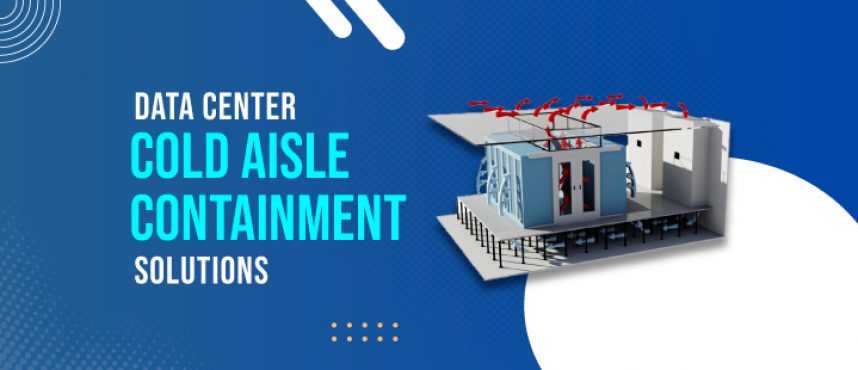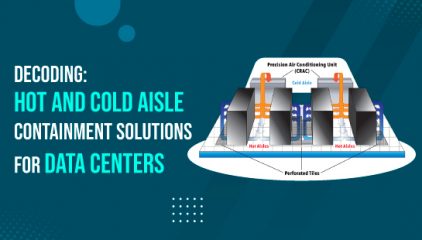Data Center Cold Aisle Containment Solutions
With the exponential rise in demand for data processing and storage, the amount of heat being produced within these facilities in India is also increasing. Hotter temperatures in data centres require flawless cooling systems, that incur further loss of electricity. This red flag has driven data center professionals to seek more efficient cooling solutions to manage rising temperatures within these facilities.
Aisle containment, whether hot or cold, has been the solution of choice for the majority of data centers. According to a study by Pacific Gas and Electric in 2017, reported by Gartner, aisle containment can minimize cool air operating costs by 20%. Subsequently, research conducted by Lawrence Berkeley National Laboratory in 2007, brought to light the fact that the electricity used to move cold supply air could be minimized by 75% with the adoption of cold aisle containment systems.
However, the hot air can disperse into the cold air close to the top of the racks and on the rear of the cold aisles. The ultimate mixed air temperatures can in some cases be unacceptably high for the servers at the top of the racks and at the end of the aisles.
The fusion of hot and cold air can be aggravated by an unbalance between the total cold air demand to the racks in the aisle and the total supply from the perforated floor tiles in the aisle. Boosting the airflow in the cold aisles may cure the unbalanced issues, but doing so will surge energy consumption, making it an ineffective solution. Aisle containment works to fix this situation. Before installing the aisle containment, however, measures should be taken to enhance overall cooling system energy efficiency. These measures can be indicated as-
- Sealing the data center environment- reduce the latent cooling load by ensuring the data center has a good vapor barrier, zero leaks through windows and doors, etc, and minimal outside air ingestion.
- Optimize Air Flow- To strategize the airflow, arrange server racks in a hot aisle/cold aisle configuration. Most equipment manufactured today is designed to draw in air through the front and frazzle it out the rear. This allows equipment racks to be arranged to make cold aisles. This strategy positions racks so that rows of racks face parallel to each other, with the anterior of every opposing row of racks feeding cold air from the same cold aisle. Hot air from two rows is exhausted into a hot aisle, increasing the temperature of the air travelingback to the computer room precision air conditioning (CRAC) unit and allowing it to operate more efficiently.
What are Cold Aisle Containment Systems?
The Cold Aisle Containment (CAC) methodology encloses the cold aisle with ceiling panels above the aisle between contiguous racks and with doors at the end of the aisle. This allows the cold air from the perforated floor tiles in front of the cabinets to be restrained and delivered to the server equipment air inlets. The cold aisle containment restricts cold air from fusing with warm air or being choked by surrounding sources/equipment before it holds out to the servers. Because CAC owns this ability, it is called focused cooling.
Types of Cold Aisle Containments-
- Cold Aisle Containments on raised floors
- Cold Aisle Containments without conventional raised floors
It is effortlessly retrofitted into existing raised floor data centers and works alongside the raised floor as well as with extreme density cooling systems to produce highly efficient cold aisle containment solutions.
The Perks of a Cold Aisle Containment System–
- Offers focused cooling at the rack
- Can bring down the temperatures of higher heat loads typically upto 10-15kW (raised floor)
- Reduces hot and cold air mixing so the return temperature to the cooling unit is higher
- In-rowcooling integrated with a cold aisle containment system can cool more than 30kW heat load per rack.
Some intriguing industry insights: – Today a data center space is expensive. Most IT companies in metro cities like Mumbai or Delhi do not clutter the top 15% of the rack due to inconsistent supply of air temperature. The space at the top of the rack is typically affected by hot exhaust air recirculation. A cold aisle containment in Mumbai and other metro cities is designed to minimize these hot spots, permitting data centers to get more out of their space. Under-populating the racks raises the space cost per server ratio (Sp -SeR). While most returns on investment formulas compute the actual cost of cooling saved, the surge in rack population alone saves companies crores of rupees towards new data center expansion. For colocation facilities, this would indicate boosted revenue per square foot.
To learn more, feel free to contact Network Techlab especially when your goal is to get your hands on bespoke assessments. For more information feel free to share your feedback or service-related questions by calling +91 8879004536 or sending an email to info@netlabindia.com.





